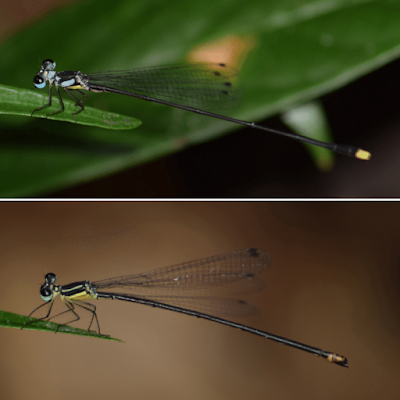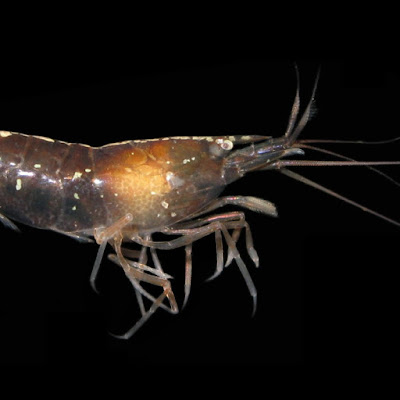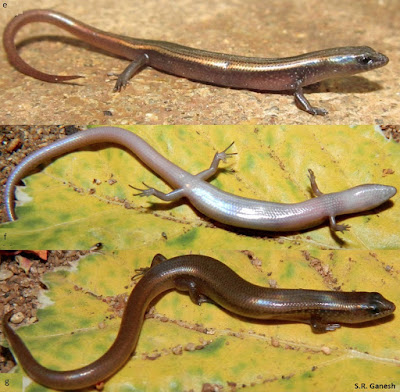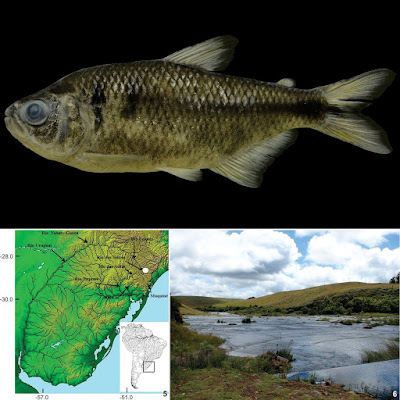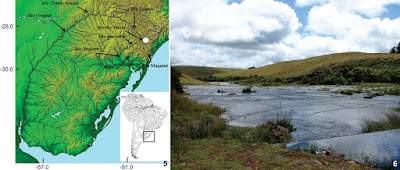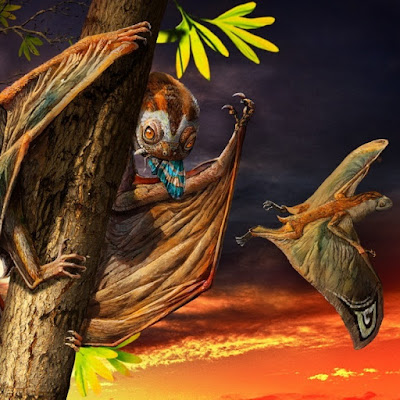[Most Recent Entries] [Calendar View]
Wednesday, September 27th, 2017
| Time | Event | ||||||
| 12:48a | [Entomology • 2017] Coeliccia duytan • A New Species of Damselfly (Odonata: Platycnemididae) from the Central Highlands of Vietnam
Abstract Coeliccia duytan sp. nov. (holotype male, from Chu Mom Ray National Park, Kon Tum Province, the Central Highlands of Vietnam, deposited in zoological collection of Duy Tan University) is described based on both sexes. The new species is closely related to C. hayashii Phan & Kompier, 2016 by the extensive rectangular pruinosity on the synthorax but differs in lacking a pale antehumeral stripe, genital ligula with flagella pointed at tip and the shape of cerci. Keywords: Odonata, Platycnemididae, Coeliccia duytan sp. nov., Vietnam
Coeliccia duytan sp. nov. Etymology. This specific epithet is derived from my office Duy Tan University; duytan, a noun in apposition. Habitat and Ecology. This is a shy species, usually perching ca. 20–30 cm high in dark forest underlain with decomposing leaf litter. It was found at streams (4–6m width) with large stones in pristine forest. At the type locality, this species occurs with two other congeners C. mientrung Kompier & Phan, 2017 and C. dydima (Selys, 1863) (new record for Vietnam, unpublished). Quoc Toan Phan. 2017. Coeliccia duytan sp. nov. from the Central Highlands of Vietnam (Odonata: Platycnemididae). Zootaxa. 4324(1); 195–200. DOI: 10.11646/zootaxa.4324.1.12 | ||||||
| 1:36a | [Crustacea • 2017] Athanas alpheusophilus (Decapoda: Alpheidae) • A New Alpheus-associated Shrimp from the Russian Coast of the Sea of Japan
Abstract A new alpheid shrimp, Athanas alpheusophilus sp. nov., is described on the basis of numerous mature specimens collected from burrows of Alpheus brevicristatus De Haan, 1844 in Vityaz Bay, which is part of Posjeta Bay on the Russian side of the Sea of Japan. The new species belongs to “Athanas dimorphus” species complex and can be clearly separated from Athanas japonicus Kubo, 1936 and relative species by unique combination of morphological features of male and female pereiopods I (chelipeds) and some other features. Moreover, Athanas alpheusophilus sp. nov. is the first species of the genus Athanas Leach, 1814 reported as a symbiont of larger burrowing snapping shrimps of the genus Alpheus Fabricius, 1798 (Crustacea: Decapoda: Alpheidae). Some taxonomic remarks on A. japonicus and related species are provided and Athanas lamellifer Kubo, 1940 is revalidated based on morphology of the male pereiopods I. Keywords: Crustacea, Malacostraca, Decapoda, Alpheidae, shrimp, Athanas, new species, commensalism, Alpheus-associated, Sea of Japan, Russia, North-West Pacific Ivan Marin. 2017. Athanas alpheusophilus sp. nov. (Decapoda: Alpheidae)— A New Alpheus-associated Shrimp from the Russian coast of the Sea of Japan. Zootaxa. 4324(1); 50–62. DOI: 10.11646/zootaxa.4324.1.3 | ||||||
| 3:21a | [Herpetology • 2017] On the Poorly-known White-spotted Skink Lygosoma albopunctatum (Gray, 1846) (Reptilia: Scincidae) with Further Topotypical Records and Notes on the Type Locality
Abstract The White-spotted Skink Lygosoma albopunctatum, a rarely recorded lizard, has been re-sighted from its type locality: Madras in the Coromandel Coastal Plains. Morphological details and field notes on the findings are elaborated. Since many past surveys in and around Madras, and in southern India generally, did not record this species, lack of consensus about its existence in southern India had developed, leading to published misconceptions about its distribution. These are highlighted and corrected herein. The species is also illustrated in life based on topotypical examples. Keywords: Distribution, lizard, morphology, scalation, southern India, type locality.
Lygosoma albopunctatum (Gray, 1846) Riopa albopunctata Gray, 1846 Riopa albopunctata - Jerdon, 1853; Smith 1935 [part] Eumeces albopunctatus - Günther, 1864 Lygosoma albopunctatum - Boulenger, 1887 [part] 1890; Das 2010 Lygosoma albopunctata (sic) - Das, 1996; Daniels 2002; Vyas 2010 DISCUSSION: A study on the molecular phylogeny of Indian Lygosoma species (Datta-Roy et al. 2014) remarked that this species, though often assigned to the genus Riopa, is nested within Lygosoma. The study also delineates that the sampled congeners of the Indian radiation “are largely confined to the Indian subregion except L. albopunctata (sic) which is also distributed in mainland Southeast Asia” (Datta-Roy et al. 2014). Their phylogenetic tree reveals weak genetic structure within multiple populations of L. albopunctatum sampled from multiple unspecified localities. Though Datta-Roy et al. (2014) recovered an Indian endemic Lygosoma pruthi (Sharma 1977) as a sister to a Southeast Asian radiation they did opine that the Indian radiation consisted of, apart from the endemics, two widespread species L. punctatum and L. albopunctatum. Stoliczka (1872) stated that individuals from south India have a rather uniform brown back whereas those from Bengal have black spotted lines along six median scale rows down the back, almost resembling L. punctatum. Ahmed et al. (2009), Islam & Saika (2013) and Sarker (2014) all illustrated L. albopunctatum from the Eastern Himalayan and Brahmaputhra regions. The photographs clearly show a more orangish tail in juveniles, contrasting with their brown trunk colour. Given the enormous distance and geo-ecological differences between peninsular and northeastern parts of the Indian subcontinent, such variations and tail colour difference in young ones might indicate cryptic diversity of Indochinese populations. In fact some literature (e.g., Das 2010) that currently ascribes as L. albopunctatum actually excluded its original definition by virtue of type series and / or type locality, as elaborated herein. Nevertheless, even admitting such lack of consensus on its global distribution and population systematics, it is here clarified beyond doubt that this species is very much present in southern India, especially along the Coromandel Coastal Plains (also see Ganesh & Chandramouli 2007; Nath et al. 2012), where lies its type locality. S.R. Ganesh. 2017. On the Poorly-known White-spotted Skink Lygosoma albopunctatum (Gray, 1846) (Reptilia: Scincidae) with Further Topotypical Records and Notes on the Type Locality. Journal of Threatened Taxa. 9(9); 10662–10668. DOI: 10.11609/jott.3376.9.9.10662-10668 | ||||||
| 1:35p | [Ichthyology • 2017] Astyanax taurorum • A New Species (Characiformes: Characidae) from dos Touros River, Pelotas River Drainage, An Upland southern Brazilian River
Abstract A new species of Astyanax belonging to the Astyanax scabripinnis complex is described from dos Touros River, tributary of the Pelotas River, Uruguay River basin. Astyanax taurorum sp. nov. is distinguished from other species of the Astyanax scabripinnis species complex by having two humeral spots, the first vertically elongated; teeth of inner row of premaxilla with three to five cusps; 2–3 (modes 2 or 3) maxillary teeth; 20–23 (mode 22) branched anal-fin rays; 13–15 (mode 14) gill rakers on lower branch of the first branchial arch; 20–23 (mode 21) total gill rakers in first branchial arch; 33–36 (mode 35) perforated lateral line scales. Astyanax taurorum sp. nov. is similar to Astyanax paris; nevertheless, it can be readily distinguished from it by having a smaller head depth (73.6-83.1% vs. 86.4–95.6%) and smaller interorbital width (24.1–28.0% vs. 30.8–32.8%). In addition, it differs from A. paris by the presence a posttemporal hook-shaped posterodorsal margin. Key words: Taxonomy, Rio Grande do Sul, Uruguay River, distribution
Astyanax taurorum sp. nov. Etymology: The specific name taurorum, is derived from the Latin masculine noun taurus (second declension, meaning bull) inflected in the plural and genitive case. Therefore taurorum means “of the bulls” in reference to “rio dos Touros“ (= Portuguese, which means “river of the bulls”) the type locality. Distribution and habitat: Astyanax taurorum sp. nov. is known from the dos Touros River drainage, tributary of Pelotas River, which in turn is a tributary of Uruguay River (Fig. 5). The Pelotas River drainage is located in the region named “Campos de Altitude do Planalto das Araucárias (= Araucaria Plateau in Bertaco et al. 2016)” or “Campos de Cima da Serra”, which has a high level of endemism of fishes (Malabarba et al. 2009, Bertaco et al. 2016: 430) and other groups of animals (for example: sponges, Ribeiro et. al. 2009; crustaceans, Bond-Buckup et al. 2009). The dos Touros River tributary, type locality of Astyanax taurorum sp. nov., has a low to medium flow, transparent waters with stones and rocks on the bottom and moderate emergent marginal vegetation (Fig. 6). Four characid species were caught along with Astyanax taurorum sp. nov.: Bryconamericus patriciae Silva, 2004, B. iheringi Boulenger, 1887, Cheirodon interruptus Jenyns, 1842, and Oligosarcus brevioris Menezes, 1987. Carlos Alberto S. de Lucena, Amanda Bungi Zaluski and Zilda Margarete Seixas de Lucena. 2017. Astyanax taurorum A New Species from dos Touros River, Pelotas River Drainage, An Upland southern Brazilian River (Characiformes: Characidae). Zoologia. 34; 1-8. DOI: 10.3897/zoologia.34.e20174 | ||||||
| 2:03p | [Paleontology • 2017] Versperopterylus lamadongensis • A New Anurognathid Pterosaur with Evidence of Perching Behaviour from Jianchang of Liaoning Province, China
Abstract A new anurognathid pterosaur, Versperopterylus lamadongensis gen. et sp. nov., is erected based on a complete skeleton with a skull preserved. It is characterized by two short distinct ridges present on the ventral surface of the cervical vertebrae; coracoids slightly longer than scapula; humerus, wing phalanx 3 and tibia nearly the same in length; grooves clearly present on the posterior surface of the wing phalanges 1–3; and the first toe reversed. It is the first anurognathid pterosaur from China with a definitively short tail, and the first pterosaur with a reversed first toe. The reversed first toe of Versperopterylus indicates that it had arboreal habitats. The discovery of Versperopterylus lamadongensis from the Jiufotang Formation strongly expands the geological age range for anurognathid pterosaurs. Systematic palaeontology Pterosauria Kaup, 1834 Anurognathidae Kuhn 1937 Versperopterylus lamadongensis gen. et sp. nov. Etymology. Versper-, Latin word for ‘dusk’ implying that the new pterosaur may seek food at dusk; -pteryl, Latin word for ‘wing’. The specific name is referred to the fossil locality, lamadong of Jianchang County, Liaoning Province. Type specimen. An almost complete skeleton with skull and jaws (BMNHC-PH-001311). The specimen is now stored in the Beijing Museum of Natural History. Locality and horizon. Lamadong goumen, Jianchang County, Liaoning Province; Jiufotang Formation.
Conclusion Versperopterylus is the first anurognathid pterosaur from China preserved with a clearly reduced tail, and it is also the youngest anurognathid pterosaur in geological age. The reversed first toe of Versperopterylus may indicate that it, perhaps, has a gripping adaptation. Junchang Lü, Qingjin Meng, Baopeng Wang, Di Liu, Caizhi Shen and Yuguang Zhang. 2017. Short Note On A New Anurognathid Pterosaur with Evidence of Perching Behaviour from Jianchang of Liaoning Province, China. in D. W. E. Hone, M. P. Witton and D. M. Martill (eds) New Perspectives on Pterosaur Palaeobiology. Geological Society, London, Special Publications, 455. DOI: 10.1144/SP455.16 |
| << Previous Day |
2017/09/27 [Calendar] |
Next Day >> |
